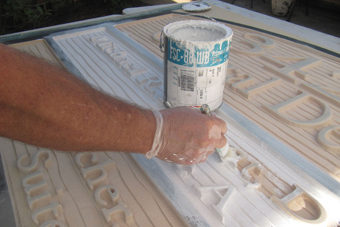Being able to work with high-density urethane (HDU) is always a thrill for me, especially since these opportunities mean that I will be working on one of my favorite type of projects here in the shop—dimensional signage (usually of the architectural and/or identity variety).
Sometimes a dimensional sign sale just happens to fall in one’s lap, which recently happened here when my wife, Sherry, visited a new dentist thanks to the one we had been using having retired a few months back.
When Sherry was getting ready to leave after her exam, the dentist asked her what type of business we were in. She explained to him that we had a sign shop that specialized in sandblasted and carved signs.
A few weeks passed, and our phone rang. Said-dentist called up our office, asking us to give him a estimate on a new hand-carved sign. It seems that the sandblasted redwood one he’d been using had been damaged by graffiti earlier that week.
The first thing that popped into my mind was that this particular sign had definitely seen its better days. The sign was already weather-beaten, so even before the vandals had gotten hold of it, one could plainly see that it was ready for a replacement.
(Note: The other thing that I had noticed about this sign when driving past it was that it was probably already at least fifteen years old, which meant that it was probably time to do something about it anyway.)
Planning
After agreeing to peform this sign upgrade for our dentist, I took the opportunity to think ahead—especially taking durability into consideration. I wanted to make sure that he was going to have a sign that would last for many years to come.
So the first decision we made was to use HDU as the substrate of choice for this sign.
We selected two sheets of fifteen-pound, one-and-a-half-inch-thick Precision Board™ purchased from our friend, Kellie Miller at Coastal Enterprises, and loaded them into the back of our truck.
Now it was time for the fun to begin, as we started crafting a new sign that would stand the test of time for our dentist!
Fabrication
Unloading our beautiful Precision Board blanks back at our shop, we discovered yet another perfect shipment. There were no dings, no breaks—just two flawless surfaces to create our magic.
We decided on a nice radial top for the street address.

Below this address, we created our patterns for each of the dentists working at this location
Using our router and Dremel tool, we cut the background down by one-half-inch, leaving the letters at their full one-and-a-half-inch height.
After routing around the letters, we then used emery boards to gently add rounded edges to each raised letter. This process gives a greater custom appearance and a greater perceived value of the overall project.
However it became apparent that a smooth background for this sign would not work at all.
Using my carving gouges, I quickly created some faux grain into the Precision Board.
This step was actually the longest part of the project; however, if we want the beauty of the faux wood grain effect, we must put in the time to make it appear as real as possible.
I always enjoy this step, as I create my backgrounds with great care. I always make sure that I never rush this process.
When I was satisfied with my wood grain effect, I took the two Precision Board sign faces and gave them a thorough rinsing with water. This was done to remove any extraneous dust and contaminants.
After drying the two faces, we applied Precision Board FSC-88 primer in two thin coats to the faces and allowed them to dry.
After a thorough drying, I applied the latex semi-gloss brown paint, again in two thin coats with ample drying time.
I then applied the lettering color, a muted beige, with sponge brushes, patting the paint gently onto each letter surface.
Installation
To anchor this beautiful sign, we dug two twelve-inch diameter holes, thirty inches deep, and lined the holes with individual Sonotube concrete forms.
Next we added concrete, one bag at a time, adding water and agitating the concrete to pack it tight into each hole.
The concrete was smoothed at the top of each Sonotube; this resulted in a really nice appearance.
Finally we replaced the grass around the Sonotubes and leveled the ground to the previous conditions.
Reaction

The difference between the “old” and the “new” sign is like night and day—or pre-cleaning and post-cleaning, dentally speaking. In fact, the dentist was extremely pleased with his new sign, as it does a better job of identifying his location and will last for years to come.
Of all the signs I have made over the last thirty-nine years of owning and operating my sign company, I would have to say those dimensional ones fabricated out of HDU are my favorite to work on, this one being another high point.
By Mark K. Roberts, a thirty-nine year sign designer, fabricator, and installer living in the beautiful city of Houston, Texas and is the owner of The InterSign Group.











